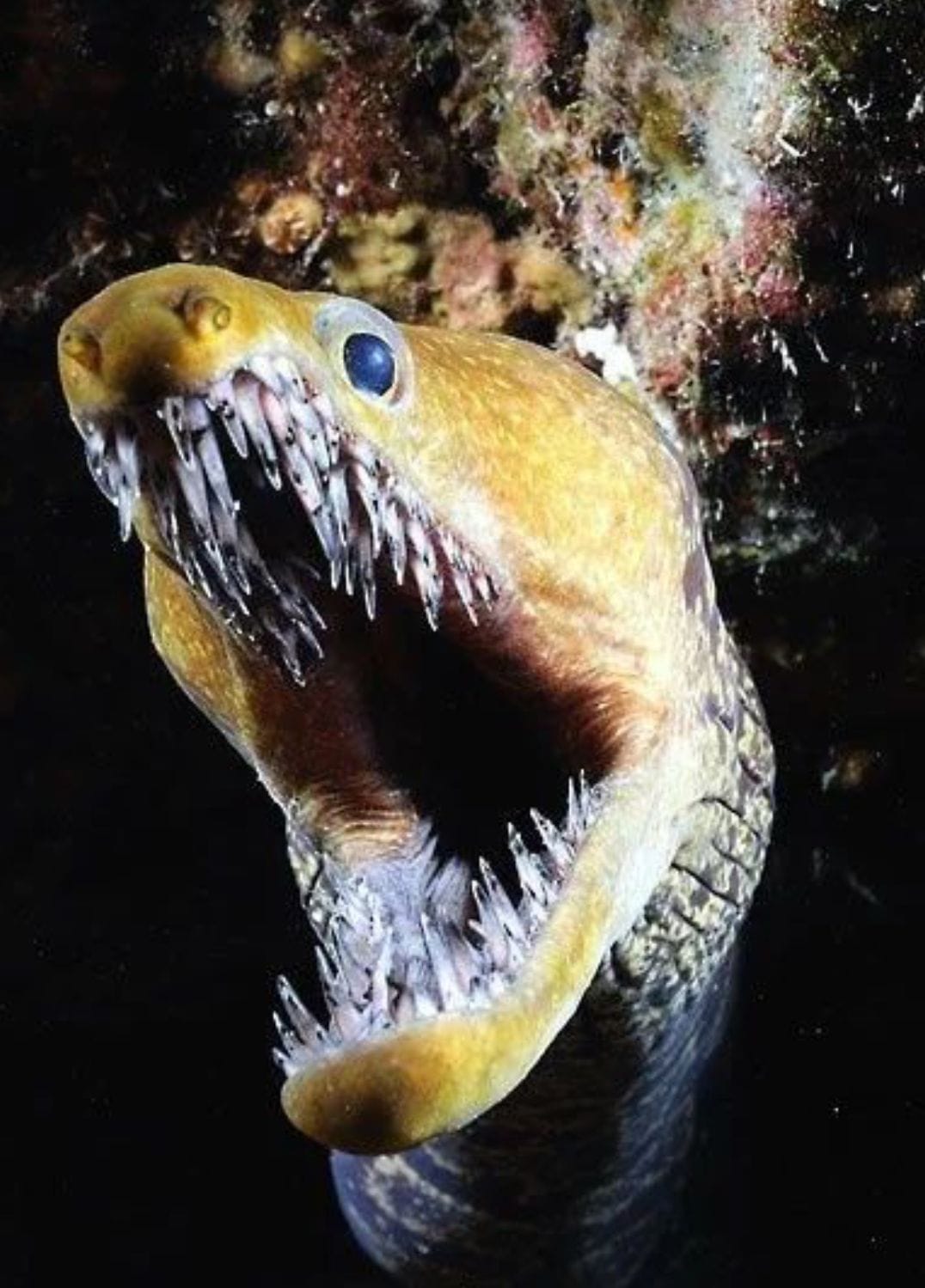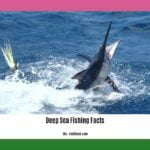Dive into the shadowy depths of the Pacific and encounter the enigmatic deep-sea wolf eel. Don’t let the fierce visage and razor-sharp teeth fool you – these creatures are surprisingly gentle giants. Uncover the fascinating world of the wolf eel, from its incredible adaptations to its vital role in maintaining the delicate balance of the ocean’s ecosystem.
Unmasking the Gentle Giant of the Deep
Imagine a creature gliding through kelp forests and rocky reefs, its sinuous body reaching lengths of over 8 feet. This is the deep-sea wolf eel, a resident of the Pacific Ocean shrouded in misconception. While their name might conjure images of ferocious predators, these animals are surprisingly docile, playing a crucial role in the delicate harmony of their underwater ecosystems.
One glance at a wolf eel reveals the origin of its name. Their imposing jaws and sharp teeth, perfectly designed for crushing prey, contribute to their rather intimidating appearance. Interestingly, their appearance transforms with age. Young wolf eels sport vibrant orange spots that fade to a mottled gray or brown in adulthood.
Despite their somewhat menacing appearance, wolf eels are solitary and peaceful. They prefer the tranquility of the deep, making their homes in rocky reefs and kelp forests. Intriguingly, they’ve been known to share their dens with octopuses – a testament to their tolerant nature and perhaps a hint at complex relationships within their underwater neighborhoods.
Perhaps the most endearing characteristic of these creatures is their dedication to family. Unlike many fish species, wolf eels form strong, monogamous bonds that last a lifetime. Both parents take an active role in raising their young, fiercely guarding their eggs within the den until they hatch.
The importance of wolf eels extends far beyond their individual lives. As a keystone species, they play a critical role in keeping their ecosystems healthy and balanced, especially when it comes to the vitality of kelp forests. Their appetite for sea urchins helps to keep these spiny creatures in check, preventing them from overgrazing and decimating the kelp forests that provide food and shelter for a myriad of marine species.
Facing an Uncertain Future: Threats to the Wolf Eel
Unfortunately, these gentle giants are facing increasing threats, largely due to human activities. Habitat loss, accidental capture in fishing gear (known as bycatch), and the looming impacts of climate change all cast a shadow over their future. Ocean acidification, a consequence of increased carbon dioxide in the atmosphere, poses a particular threat, as it can impact the availability of prey and even interfere with the formation of shells in the creatures wolf eels rely on for food.
The good news is that efforts are underway to protect these remarkable animals. Sustainable fishing practices are being implemented to reduce bycatch, and marine protected areas offer a safe haven for wolf eels and other marine life. Scientists are also hard at work studying these creatures to better understand their needs and develop effective conservation strategies.
You can be part of the solution too! Citizen science programs offer opportunities for individuals to contribute to the monitoring and protection of wolf eels. By working together, we can ensure that these gentle giants continue to grace our oceans for generations to come. Every piece of information we gather, every step we take to lessen our impact on their environment, brings us closer to unraveling the mysteries and ensuring the survival of the fascinating deep-sea wolf eel.
Myths vs. Reality: Are Wolf Eels Aggressive?
“With an unsettling face and muscular body, the wolf eel resembles mythical beasts from seafaring tales of yore.” – All That’s Interesting
It’s easy to see why people might be intimidated by wolf eels. But are they really the monsters of the deep? Despite their imposing jaws and sharp teeth, wolf eels pose little threat to humans. In fact, they are considered harmless by marine experts.
Divers often report wolf eels swimming alongside them, displaying curiosity rather than aggression. While there have been rare instances of wolf eel bites, these are usually cases of mistaken identity or self-defense when the animal feels threatened or cornered.
Their gentle nature is perhaps best exemplified by their dedication to family. Wolf eels form monogamous pairs and exhibit remarkable parental care. Both parents diligently guard their eggs within their den, a testament to their nurturing side.
Delving Deeper: A Closer Look at the “Wolf” in Wolffish
While they may resemble their eel counterparts, wolf eels aren’t true eels at all. They belong to the family Anarhichadidae, sharing characteristics with both eels and catfish. Their scientific name, Anarhichas lupus, hints at their wolf-like attributes, particularly their powerful jaws and impressive teeth.
These remarkable fish can grow up to 8 feet long and weigh over 40 pounds. Their bodies are elongated and somewhat compressed, allowing them to navigate through rocky crevices and kelp forests with ease. Their coloration, as mentioned earlier, changes with age, transitioning from vibrant orange in juveniles to a more subdued gray or brown in adults.
A Vital Link: The Wolf Eel’s Role in the Ecosystem
Wolf eels are considered a keystone species, meaning their presence has a disproportionately large impact on their environment. They are essential for maintaining a healthy balance within their ecosystem, particularly in kelp forests.
Their diet consists primarily of hard-shelled invertebrates like crabs, sea urchins, and mussels. Their powerful jaws and teeth are perfectly adapted for crushing the shells of their prey, preventing these populations from exploding and disrupting the delicate ecosystem balance.
Overfishing or a decline in wolf eel populations can have cascading effects on the entire food web. For example, an unchecked sea urchin population can decimate kelp forests, leading to habitat loss for a wide range of marine species.
Protecting the Gentle Giants: Conservation Efforts
Recognizing the ecological importance of wolf eels and the threats they face, conservation efforts are crucial to ensuring their survival. These efforts include:
- Sustainable Fishing Practices: Implementing fishing gear and methods that minimize bycatch, reducing the accidental capture of wolf eels.
- Marine Protected Areas: Establishing designated zones where fishing and other potentially harmful activities are restricted, providing safe havens for wolf eels and their prey.
- Research and Monitoring: Conducting scientific studies to better understand wolf eel populations, their habitat requirements, and the impact of human activities on their survival.
- Citizen Science: Engaging the public in data collection and monitoring efforts, empowering individuals to contribute to wolf eel conservation.
By supporting these initiatives and promoting responsible interactions with the marine environment, we can help ensure that these fascinating and gentle giants continue to thrive in the depths of our oceans for generations to come.
If you think you’ve seen it all with sea creatures, wait till you see the deep sea wolf eel that has an eel-like body but with wolf-like features, or a deer with fangs that looks like a mythical creature out of a fantasy movie. And if you’re into animals with genetic conditions, you need to check out the down syndrome giraffe and down syndrome lion which look like they came straight out of a Disney movie.












